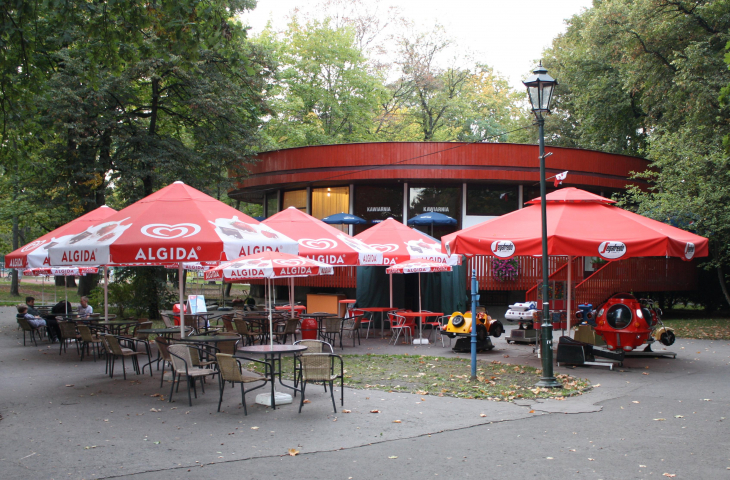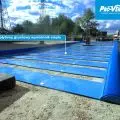A new museum is scheduled to open in Krakow in 2023. The exhibition is to be about sports, displaying medals and memorabilia of outstanding athletes, as well as being multimedia and interesting for the youngest. However, the choice of location - the reconstructed "okrąglak" in Jordan Park - has come under criticism.
The initiators of the sports museum are Krakow's athletes and Olympic medalists Barbara Slizowska and Henryk Kasperczak. The museum facility would exhibit medals and sports memorabilia. They would be accompanied by multimedia exhibitions prepared to interest and inspire the youngest viewers. After reconstruction, the pavilion would also serve its current function - a café. The place would inspire the younger generations and promote physical activities.
We decided that this is the only chance, perhaps the last chance, to preserve these memorabilia for the people of Cracow, so that this history of sports really had here such a strong basis for showing what happened in Cracow for more than 100 years. In the Henryk Jordan Park, in the so-called okrąglak, commonly known to Cracovians, after renovation, it will be an ideal place to combine cafe functions and the function of a historical museum, but also with the youth in mind, we want it to be a multimedia museum," says Janusz Kozioł about the idea in the material on the official channel of the City of Cracow on the YouTube platform.
© City of Krakow
Marek Kozminski, an Olympic medalist from Barcelona 1992, expressed himself positively about the idea and the location of the facility in the same material:
I, for one, can't think of a better place where someone will go skating or cycling and be able to enter such a place, see this history of Krakow's sport on the international stage, to realize how rich it is.
The location, however, raises objections, for the roundhouse in Jordan Park has an emotional value for Krakow and its residents.
Jordan Park and okrąglak
The history of the site dates back to the end of the 19th century, when, on the initiative of Henryk Jordan, a park complex was established in the Czarnowiejskie marshes. The founder's goal was to create a place where children and young people could spend active time playing and exercising. Henry Jordan was one of the initiators of the popularization of physical activity among the youngest. He attached great importance to the proper education of young people. The place was to fulfill recreational functions, for which there was previously no place. An additional element was to be busts of important figures in the history of Poland, quantitatively maintained in appropriate proportions in relation to green areas and sports infrastructure.
photo shows the roundhouse from a few years ago
Photo: Januszk57| Wikimedia Commons © CC BY 3.0.
On the site of the current okrąglak at the time of the park's establishment stood Ewelina Dobrzyńska' s dairy, operating there until 1912. The wooden building has not been preserved. The current structure was built in 1974. The roundhouse served as a cafe for park users only in the summer, the facility was not adapted for use in the winter season. The building was remembered as an important place for meetings, recreation and relaxation in the green areas of Krakow.
Why did the building, despite its iconic character, end up in such a state? Over the past twenty-five years of use of the building by the Henryk Jordan Park Society, it has not undergone a major renovation.
What should the roundhouse serve?
After the announcement of the idea to organize a sports museum combined with a cafe, many people reacted critically. There were many comments on news portals suggesting that such use of the roundhouse was not a good solution. An online petition was even created against the establishment of a sports museum. The museum is expected to open in 2023, after extensive renovation or even reconstruction. Why does the idea generate such reactions?
Henryk Jordan Park
Photo: Januszk57| Wikimedia Commons © CC BY 3.0.
Under fire of criticism was not the idea of creating a sports museum itself, where the exhibition would allow to commemorate the achievements of Polish athletes and Olympians, but the chosen location. In the event of a desire to expand the exhibition, "okrąglak" is not a facility that can be expanded. What to do at a time when there is not enough space for new exhibits?
We should add that the exhibition is also to be multimedia in nature. Despite technological developments and the ever-smaller size of electronics, this still takes up space. How to accommodate an exhibition, multimedia and still a café? At some point, won't there not be enough space for any of the mentioned functions?
One should also ask whether a better place for displaying such objects would not be a sports facility? Wouldn't a display with medals and memorabilia of athletes be more impressive next to a stadium or arena?
The question is, what function would the roundhouse serve? In the voices of the outraged, a cafe is most often mentioned, but not as an addition to the facility, but as its centerpiece. In the justification of the online petition, the initiators cite the park created by Dr. Jordan was to be primarily a place for physical activity in the open air, does the idea of a museum fit in with this idea?
One of the alleys in the Henryk Jordan Park
Photo: Januszk57| Wikimedia Commons © CC BY 3.0.
In recent years, the Henryk Jordan Park Society has been accused of failing to properly care not only for the roundhouse, but also the park space. New sculptures were added to the alleys, often breaking up the layout of the alleys, and completely failing to fit into the space in the way that the white busts made in the late 19th and early 20th centuries fit.
Introducing new objects and institutions into the fabric of Henryk Jordan Park will be problematic, not because of the limited space or destruction of the spatial composition, but primarily because of the unique ideas of creating a place where children and young people could play and exercise. When introducing new institutions, this should be kept in mind.























